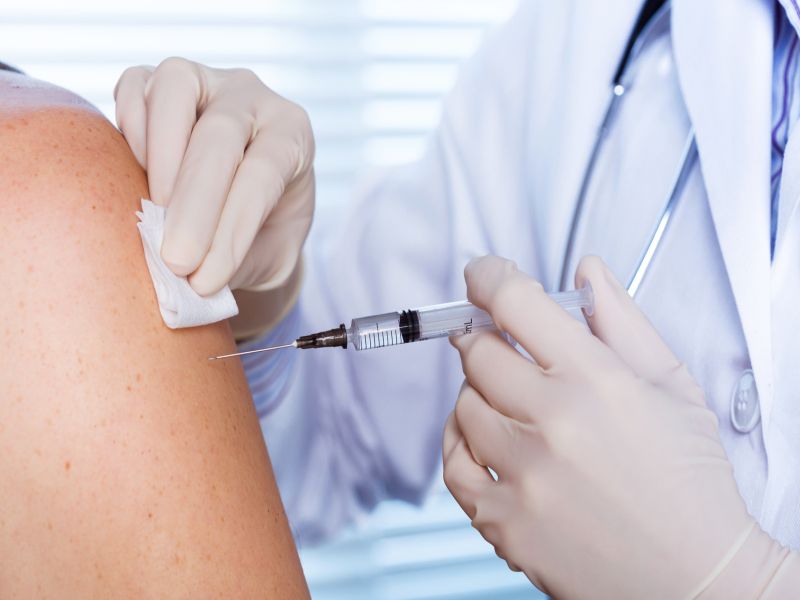Study Points to Herd Immunity Against HPV in Unvaccinated U.S. Adults
By Dennis ThompsonHealthDay Reporter

TUESDAY, Sept. 10, 2019 (HealthDay News) -- The United States could be approaching a state of herd immunity against human papillomavirus (HPV), a virus linked to several cancers.
Oral HPV infections declined by 37% among unvaccinated 18- to 59-year-old men between 2009 and 2016, according to a Sept. 10 report in the Journal of the American Medical Association.
That included a decline in infections of HPV16, the strain found in more than 9 out of 10 cases of head and neck cancer related to the virus, said senior researcher Dr. Maura Gillison, a professor of medicine at MD Anderson Cancer Center in Houston.
Researchers say men are benefitting from increased HPV vaccination rates among American women, who receive the vaccine to prevent virus-caused cervical cancer.
"In contrast to cervical cancers, we have no means by which to screen for HPV-positive head and neck cancers," Gillison said. "The vaccine is our best hope for prevention."
HPV vaccination has been recommended for girls since 2006 and for boys since 2011. The virus has been linked to cancers of the cervix, penis, anus, mouth and throat.
Vaccination rates among boys and girls are steadily rising, according to the U.S. Centers for Disease Control and Prevention.
About half of teens were up to date on the HPV vaccine in 2017, and two-thirds of 13- to 17-year-olds had received the first dose to start the series. On average, the percentage of teens who started the HPV vaccine series rose by 5 percentage points each year between 2013 and 2017, the CDC says.
"At least 75% vaccine coverage of boys and girls would be necessary to eradicate HPV16, the HPV type that is most likely to lead to cancer development," Gillison said.
But vaccination rates have lagged among males.
To see if males are receiving some protection from greater HVP vaccination among females, Gillison and her colleagues reviewed U.S. federal health survey data gathered between 2009 and 2016.
They found that by 2016, about 15% of women and 6% of men had received the vaccine.
Despite lower vaccination rates among males, oral HPV infections declined from 2.7% to 1.6% in men between 2009 and 2016.
Interestingly, prevention of oral HPV infections and the head and neck cancers they cause is not listed as a reason to get the vaccine, Gillison said. No clinical trials have been undertaken to show that the HPV vaccine could prevent such cancers.
The decrease in HPV infections among the unvaccinated men is consistent with a decline in genital HPV infections among unvaccinated women between 2004 and 2014, the researchers noted.
"This study demonstrates that even with suboptimal uptake of the HPV vaccine, important gains are being made in herd immunity against oral HPV types included in the vaccine," said Dr. Amesh Adalja, a senior scholar at the Johns Hopkins Center for Health Security in Baltimore. He was not involved with the study.
"Oral HPV infection is a major factor in the development of head and neck cancer, and this vaccine has the potential to be game-changing as more individuals are vaccinated," Adalja said.
HPV-positive head and neck cancers are the most rapidly rising cancers in the United States among men under age 60, Gillison said.
She called on doctors to use the data from this and other studies to promote HPV vaccination.
"I can guarantee that all of my patients diagnosed with HPV-positive head and neck cancer would exchange two or three shots for three months of toxic cancer therapy in a heartbeat," she said.
"The HPV vaccine, together with the hepatitis B vaccine, are the two most important advances in the history of cancer prevention, period," Gillison concluded.
More information
The American Cancer Society has more about HPV and cancer.

The news stories provided in Health News and our Health-E News Newsletter are a service of the nationally syndicated HealthDay® news and information company. Stories refer to national trends and breaking health news, and are not necessarily indicative of or always supported by our facility and providers. This information is provided for informational and educational purposes only, and is not intended to be a substitute for medical advice, diagnosis, or treatment.

